Methodology for Quantifying the Energy Saving Potentials Combining Building Retrofitting, Solar Thermal Energy and Geothermal Resources
Abstract
1. Introduction
2. Materials and Methods
2.1. Solar Resource
2.2. Geothermal Resource
2.3. Urban Data
2.4. Building Energy Demand
- Development of building models.
- Development of a dynamic simulation environment.
- Post-processing evaluation and creation of building analysis modules.
2.4.1. Phase 1: Development of Building Models
- Single family houses: two-storey house with 100 m2 of floor area and a height between floors of 3 m (Case 1 and 2).
- Blocks of houses: four (Case 3 and 4), seven (Case 5 and 6) and ten (Case 7 and 8) square-floor plants with 3 m height between floors.
- Regulations before 2008: 0.8 ren/h.
- Regulations after 2008:
- ○
- Single-family house: 0.3 ren/h.
- ○
- Blocks of houses: 0.24 ren/h.
- No occupancy: 0.2 ren/h.
- Occupancy: 1.2 ren/h.
2.4.2. Phase 2: Development of a Dynamic Simulation Environment
- Climate zones: C1, D1 and E1.
- Year of construction: before 1979, 1979–2008, 2008–2013 and after 2014.
- Type of window: before 1979, 1979–2008, 2008–2013 and after 2014.
- Number of plants for blocks: 4, 7 and 10.
- Surface area for blocks: 200, 400 and 800 m2.
- Percentage of shading received on windows for the main façades during summer: 0, 25, 50, 75 and 100%.
2.4.3. Phase 3: Post-Processing and Creation of the Building Analysis Matrices
2.5. Solar Savings
2.6. Geothermal Savings
- Building construction year.
- Floor surface area.
- Current fuel.
- Age of the current heating equipment.
3. Results
3.1. Solar Thermal Potential
3.2. Geothermal Potential
3.2.1. Geothermal Exchanger Length Depending on the Thermal Conductivity and Year of Construction
3.2.2. Energy and CO2 Emission Analysis
- Case 1 (Figure 10): 100 m2 building in Gijón (postal district 33697) constructed between 2009 and 2013, replacing a gas boiler with less than 15 years old. The geothermal system provides the total thermal energy required. In this case, it is a total of 29,334 kWh, of which 5987 kWh of electricity are consumed by the heat pump and 23,351 thermal kWh are obtained from the land, thus being free (79.59% of the total energy). The current gas boiler emits 8215 kg of CO2 annually, while the proposed geothermal system would emit 1980 kg of CO2. This represents an environmental saving of 6230 kg of CO2.
- Case 2 (Figure 11): 200 m2 building in Oviedo (postal district 33191) built between 1980 and 2008, replacing a gas boiler that is less than 15 years old. In this case, 36,079 thermal kWh are obtained free of charge from the land, which represents an economic saving of about EUR 1446. There are environmental savings of 9630 kg of CO2 annually.
- Case 3 (Figure 12): 400 m2 building in Cangas del Narcea (postal district 33815) built between 1800 and 1979, replacing a gas oil boiler that is more than 15 years old. Due to the age of the building and the larger floor area, the savings are higher than in cases 1 and 2. A total of 111,788 kWh are obtained free of charge per year and 47,990 kg of CO2 are saved annually compared to the conventional system.
3.3. Retrofitting Potential
- For Spanish construction regulations before 2008 (red and orange lines):
- ○
- Zone C1: 88 to 93%.
- ○
- Zone D1: 90 to 94%.
- ○
- Zone E1: 91 to 95%.
- For Spanish construction regulations after 2008 (green and blue lines):
- ○
- Zone C1: 71 to 88%.
- ○
- Zone D1: 74 to 90%.
- ○
- Zone E1: 77 to 91%.
3.3.1. Module 1: Maximum Retrofitting Potential
3.3.2. Module 2: Customize Retrofitting Potential
- Two types of residential house: single-family and four-storey block. These typologies are the most usual in these regions.
- Two configurations for the boundary conditions: isolated and semi-detached.
- Four Spanish regulations to fix the construction requirements: before 1979, 1979–2008, 2009–2013 and after 2014.
- Three percentages of summer shadings over the main façades: 100, 50 and 0%. These percentages vary at the same time in all the façades.
4. Discussion and Conclusions
Author Contributions
Funding
Acknowledgments
Conflicts of Interest
References
- IPCC. Global Warming of 1.5 °C. An IPCC Special Report on the Impacts of Global Warming of 1.5 °C above Pre-Industrial Levels and Related Global Greenhouse Gas Emission Pathways, in the Context of Strengthening the Global Response to the Threat of Climate Change, Sustainable Development, and Efforts to Eradicate Poverty; Masson-Delmotte, V., Zhai, P., Pörtner, H.-O., Roberts, D., Skea, J., Shukla, P.R., Pirani, A., Moufouma-Okia, W., Péan, C., Pidcock, R., et al., Eds.; IPCC: Geneva, Switzerland, 2018. [Google Scholar]
- Solauna, K.; Cerdá, E. Climate change impacts on renewable energy generation. A review of quantitative projections. Renew. Sustain. Energy Rev. 2019, 116, 109415. [Google Scholar] [CrossRef]
- IRENA. Climate Change and Renewable Energy: National policies and the role of communities, cities and regions. In Report to the G20 Climate Sustainability Working Group (CASE WG); International Renewable Energy Agency: Abu Dhabi, UAE, 2019. [Google Scholar]
- Contreras-Lisperguer, R.; de Cuba, K. The Potential Impact of Climate Change on the Energy Sector in the Caribbean Region; Organization of American States: Washington, DC, USA, 2008. [Google Scholar]
- Cronin, J.; Anandarajah, G.; Dessens, O. Climate change impacts on the energy system: A review of trends and gaps. Clim. Chang. 2018, 151, 79–93. [Google Scholar] [CrossRef] [PubMed]
- Arent, D.J.; Tol, R.S.J.; Faust, E.; Hella, J.P.; Kumar, S.; Strzepek, K.M.; Tóth, F.L.; Yan, D.; Abdulla, A.; Kheshgi, H.; et al. Chapter 10 Key Economic Sectors and Services. In Climate Change 2014 Impacts, Adaptation and Vulnerability: Part A: Global and Sectoral Aspects; Cambridge University Press: Cambridge, UK, 2010; pp. 659–708. [Google Scholar]
- Ebinger, J.; Vergara, W. Climate Impacts on Energy Systems: Key Issues for Energy Sector Adaptation; The International Bank for Reconstruction and Development/The World Bank: Washington, DC, USA, 2011. [Google Scholar]
- Johnston, P.C. Climate Risk and Adaptation in the Electric Power Sector; Asian Development Bank: Manila, Philippines, 2012. [Google Scholar]
- Schaeffer, R.; Szklo, A.S.; de Lucena, A.F.P.; Borba, B.S.M.C.; Nogueira, L.P.P.; Fleming, F.P.; Troccoli, A.; Harrison, M.; Boulahya, M.S. Energy sector vulnerability to climate change: A review. Energy 2012, 38, 1–12. [Google Scholar] [CrossRef]
- Sánchez, M.N.; Soutullo, S.; Olmedo, R.; Bravo, D.; Castaño, S.; Jiménez, M.J. An experimental methodology to assess the climate impact on the energy performance of buildings: A ten-year evaluation in temperate and cold desert areas. Appl. Energy 2020, 264, 114730. [Google Scholar] [CrossRef]
- Cao, X.; Dai, X.; Liu, J. Building energy-consumption status worldwide and the state-of-the-art technologies for zero-energy buildings during the past decade. Energy Build. 2016, 128, 198–213. [Google Scholar] [CrossRef]
- Soutullo, S.; Giancola, E.; Jiménez, M.J.; Ferrer, J.A.; Sánchez, M.N. How Climate Trends Impact on the Thermal Performance of a Typical Residential Building in Madrid. Energies 2020, 13, 237. [Google Scholar] [CrossRef]
- European Energy Research Alliance. EERA JPSC MAPPING: Positive Energy Districts (PEDs) and Neighbourhoods. Available online: https://www.eera-set.eu/eera-joint-programmes-jps/list-of-jps/smart-cities/mapping-positive-energy-districts-neighbourhoods/ (accessed on 30 September 2020).
- Temporary Working Group of the European Strategic Energy Technology (SET)-Plan on Action 3.2 “Smart Cities and Communities”. Implementation Plan, Europe to become a Global Role Model in Integrated, Innovative Solutions for the Planning, Deployment, and Replication of Positive Energy Districts. Available online: https://setis.ec.europa.eu/system/files/setplan_smartcities_implementationplan.pdf (accessed on 30 September 2020).
- Li, C. GIS for Urban Energy Analysis. Compr. Geogr. Inf. Syst. 2018, 187–195. [Google Scholar] [CrossRef]
- Cabeza, L.F.; Chàfer, M. Technological options and strategies towards zero energy buildings contributing to climate change mitigation: A systematic review. Energy Build. 2020, 219, 110009. [Google Scholar] [CrossRef]
- Abbasabadi, N.; Ashayeri, M. Urban energy use modeling methods and tools: A review and an outlook. Build. Environ. 2019, 161, 106270. [Google Scholar] [CrossRef]
- Soutullo, S.; Giancola, E.; Heras, M.R. Dynamic energy assessment to analyze different refurbishment strategies of existing dwellings placed in Madrid. Energy 2018, 152, 1011–1023. [Google Scholar] [CrossRef]
- Terés-Zubiaga, J.; Bolliger, R.; Almeida, M.G.; Barbosa, R.; Rose, J.M.; Thomsen, K.E.; Montero, E.; Briones-Llorente, R. Cost-effective building renovation at district 1 level combining energy efficiency & renewable. Methodology assessment proposed in IEA-Annex 75 and a demonstration case study. Energy Build. 2020, 224, 110280. [Google Scholar]
- de Santoli, L.; Mancini, F.; Garcia, D.A. A GIS-based model to assess electric energy consumptions and usable renewable energy potential in Lazio region at municipality scale. Sustain. Cities Soc. 2019, 46, 101413. [Google Scholar] [CrossRef]
- Alhamwi, A.; Medjroubi, W.; Vogt, T.; Agert, C. FlexiGIS: An open source GIS-based platform for the optimisation of flexibility options in urban energy systems. In Proceedings of the CUE2018-Applied Energy Symposium and Forum 2018: Low Carbon Cities and Urban Energy Systems, Shanghai, China, 5–7 June 2018. [Google Scholar]
- Wang, H.; Pan, Y.; Luo, X. Integration of BIM and GIS in sustainable built environment: A review and bibliometric analysis. Autom. Constr. 2019, 103, 41–52. [Google Scholar] [CrossRef]
- Marzouk, M.; Othman, A. Planning utility infrastructure requirements for smart cities using the integration between BIM and GIS. Sustain. Cities Soc. 2020, 57, 102120. [Google Scholar] [CrossRef]
- Pedro, J.; Silva, C.; Duarte Pinheiro, M. Integrating GIS spatial dimension into BREEAM communities sustainability assessment to support urban planning policies, Lisbon case study. Land Use Policy 2019, 83, 424–434. [Google Scholar] [CrossRef]
- Krietemeyer, B.; El Kontar, R. A method for integrating an UBEM with GIS for spatiotemporal visualization and analysis. In Proceedings of the 10th Annual Symposium on Simulation for Architecture and Urban Design Conference SimAUD 2019, Atlanta, GA, USA, 7–9 April 2019; Simulation Series. Volume 51, pp. 87–94. [Google Scholar]
- Gaspari, J.; De Giglio, M.; Antonini, E.; Vodola, V. A GIS-Based Methodology for Speedy Energy Efficiency Mapping: A Case Study in Bologna. Energies 2020, 13, 2230. [Google Scholar] [CrossRef]
- Li, C.; Song, Y.; Kaza, N.; Burghardt, R. Explaining Spatial Variations in Residential Energy Usage Intensity in Chicago: The Role of Urban Form and Geomorphometry. J. Plan. Educ. Res. 2019, 1–15. [Google Scholar] [CrossRef]
- Torabi Moghadam, S.; Toniolo, J.; Mutani, G.; Lombardi, P. A GIS-statistical approach for assessing built environment energy use at urban scale. Sustain. Cities Soc. 2018, 37, 70–84. [Google Scholar] [CrossRef]
- Ahn, Y.; Sohn, D.W. The effect of neighbourhood-level urban form on residential building energy use: A GIS-based model using building energy benchmarking data in Seattle. Energy Build. 2019, 196, 124–133. [Google Scholar] [CrossRef]
- Zheng, Y.; Weng, Q. Modeling the effect of climate change on building energy demand in Los Angeles county by using a GIS-based high spatial- and temporal resolution approach. Energy 2020, 176, 641–655. [Google Scholar] [CrossRef]
- Praene, J.P.; Malet-Damour, B.; Radanielina, M.H.; Fontaine, L.; Rivière, G. GIS-based approach to identify climatic zoning: A hierarchical clustering on principal component analysis. Build. Environ. 2019, 164, 106330. [Google Scholar] [CrossRef]
- García-Ballano, C.J.; Ruiz-Varona, A.; Casas-Villarreal, L. Parametric-based and automatized GIS application to calculate energy savings of the building envelope in rehabilitated nearly zero energy buildings (nZEB). Case study of Zaragoza, Spain. Energy Build. 2020, 215. [Google Scholar] [CrossRef]
- Mokhtara, C.; Negrou, B.; Settou, N.; Gouareh, A.; Settou, B. Pathways to plus-energy buildings in Algeria: Design optimization method based on GIS and multi-criteria decision-making. Energy Proc. 2019, 162, 171–180. [Google Scholar] [CrossRef]
- Re Cecconi, F.; Moretti, N.; Tagliabue, L.C. Application of artificial neutral network and geographic information system to evaluate retrofit potential in public school buildings. Renew. Sustain. Energy Rev. 2019, 110, 266–277. [Google Scholar] [CrossRef]
- Sarmiento, N.; Belmonte, S.; Dellicompagni, P.; Franco, J.; Escalante, K.; Sarmiento, J. A solar irradiation GIS as decision support tool for the Province of Salta, Argentina. Renew. Energy 2018, 132, 68–80. [Google Scholar] [CrossRef]
- Ferla, G.; Caputo, P.; Colaninno, N.; Morello, E. Urban greenery management and energy planning: A GIS-based potential evaluation of pruning by-products for energy application for the city of Milan. Renew. Energy 2020, 160, 185–195. [Google Scholar] [CrossRef]
- Hendel, M.; Bobée, C.; Karam, G.; Parison, S.; Berthe, A.; Bordin, P. Developing a GIS tool for emergency urban cooling in case of heat-waves. Urban Clim. 2020, 33, 100646. [Google Scholar] [CrossRef]
- Viana-Fons, J.D.; Gonzálvez-Maciá, J.; Payá, J. Development and validation in a 2D-GIS environment of a 3D shadow cast vector-based model on arbitrarily orientated and tilted surfaces. Energy Build. 2020, 224, 110258. [Google Scholar] [CrossRef]
- Liang, J.; Gong, J.; Zhang, J.; Li, Y.; Wu, D.; Zhang, G. GSV2SVF-an interactive GIS tool for sky, tree and building view factor estimation from street view photographs. Build. Environ. 2020, 168, 106475. [Google Scholar] [CrossRef]
- Soutullo, S.; Giancola, E.; Franco, J.M.; Boton, M.; Ferrer, J.A.; Heras, M.R. New simulation platform for the rehabilitation of residential building in Madrid. Energy Proc. 2017, 122, 817–822. [Google Scholar] [CrossRef]
- RehabilitaGeoSol Project Website. Available online: http://projects.ciemat.es/web/rehabilitageosol/inicio (accessed on 30 September 2020).
- Harish, V.S.K.V.; Kumar, A. A review on modeling and simulation of buildings energy systems. Renew. Sustain. Energy Rev. 2016, 56, 1272–1292. [Google Scholar] [CrossRef]
- Ascione, F.; Bianco, N.; Mauro, G.M.; Napolitano, D.F.; Vanoli, G.P. A Multi-Criteria Approach to Achieve Constrained Cost-Optimal Energy Retrofits of Buildings by Mitigating Climate Change and Urban Overheating. Climate 2018, 6, 37. [Google Scholar] [CrossRef]
- Hashempour, N.; Taherkhani, R.; Mahdikhani, M. Energy performance optimization of existing buildings: A literature review. Sustain. Cities Soc. 2020, 54, 101967. [Google Scholar] [CrossRef]
- Castro, S.S.; López, M.J.S.; Menéndez, D.G.; Marigorta, E.B. Decision matrix methodology for retrofitting techniques of existing buildings. J. Clean. Product. 2019, 240, 118153. [Google Scholar] [CrossRef]
- Prieto, J.I.; Martínez-García, J.C.; García, D.; Santoro, R.; Rodríguez, A. Mapa Solar de Asturias; Empresas Acuerdo Consorcio PSE-ARFRISOL: Gijón, Spain, 2009. [Google Scholar]
- Prieto, J.I.; Martínez-García, J.C.; García, D. Correlation between global solar irradiation and air temperature in Asturias, Spain. Sol. Energy 2009, 83, 1076–1085. [Google Scholar] [CrossRef]
- Instituto Geológico y Minero de España (IGME). Mapa Hidrogeológico de España y Mapa Geológico de España (MAGNA 50). Sheets 10–15, 25–32, 49–56, 74–80, 99–103. 1972–2003. Available online: http://info.igme.es/cartografiadigital/geologica/Magna50.aspx (accessed on 30 September 2020).
- Asociación Técnica Española de Climatización y Refrigeración (ATECYR). Guía Técnica: Diseño de Sistemas de Intercambio Geotérmico de Circuito Cerrado; Instituto para la Diversificación y Ahorro de la Energía (IDAE), Ministry of Industry, Energy and Tourism, Spanish Government: Madrid, Spain, 2012; ISBN 978-84-96680-60-9.
- Spanish Government. Norma Básica de la Edificación “NBE-CT-79” Sobre Condiciones Térmicas de los Edificios; Royal Decree 2429/1979 1979, BOE-A-1979-24866; Spanish Government: Madrid, Spain, 1979.
- Spanish Government. Código Técnico de la Edificación; Royal Decree 314/2006 2006, BOE-A-2006-5515; Spanish Government: Madrid, Spain, 2006.
- Soutullo, S.; Sánchez, M.N.; Enríquez, R.; Olmedo, R.; Jiménez, M.J. Bioclimatic vs conventional building: Experimental quantification of the thermal improvements. Energy Proc. 2017, 122, 823–828. [Google Scholar] [CrossRef]
- Soutullo, S.; Sánchez, M.N.; Enríquez, R.; Jiménez, M.J.; Heras, M.R. Empirical estimation of the climatic representativeness in two different areas: Desert and Mediterranean climates. Energy Proc. 2017, 122, 829–834. [Google Scholar] [CrossRef]
- Sánchez, M.N.; Giancola, E.; Blanco, E.; Soutullo, S.; Suárez, M.J. Experimental Validation of a Numerical Model of a Ventilated Façade with Horizontal and Vertical Open Joints. Energies 2020, 13, 146. [Google Scholar] [CrossRef]
- Salcido, J.C.; Raheem, A.A.; Isaa, R.A. From simulation to monitoring: Evaluating the potential of mixed-mode ventilation (MMV) systems for integrating natural ventilation in office buildings through a comprehensive literature review. Energy Build. 2016, 127, 1008–1018. [Google Scholar] [CrossRef]
- Díaz, J.A.; Jiménez, M.J. Experimental assessment of room occupancy patterns in an office building. Comparison of different approaches based on CO2 concentrations and computer power consumption. Appl. Energy 2017, 199, 121–141. [Google Scholar] [CrossRef]
- Tejero-González, A.; Andrés-Chicote, M.; García-Ibáñez, P.; Velasco-Gómez, E.; Rey-Martínez, F.J. Assessing the applicability of passive cooling and heating techniques through climate factors: An overview. Renew. Sustain. Energy Rev. 2016, 65, 727–742. [Google Scholar] [CrossRef]
- Giancola, E.; Sánchez, M.N.; Ferrer, J.A.; López, H.; Soutullo, S. New Platform to Quantify the Energy-Saving Potential in Existing Residential Buildings in a Northern Spanish Region. In Proceedings of the 35th International Conference PLEA 2020: Sustainable Architecture and Urban Design Planning Post Carbon Cities, A Coruña, Spain, 1–3 September 2020. [Google Scholar]
- Spanish Building Code Webpage. Available online: https://www.codigotecnico.org/index.php/menu-ahorro-energia.html (accessed on 30 September 2020).
- Carrera, A.; Sisó, L.; Herena, A.; Valle, M.; Casanova, M.; González, D. Evaluación del Potencial de Climatización con Energía Solar Térmica en Edificios; Estudio Técnico PER 2011–2020; Instituto para la Diversificación y Ahorro de la Energí (IDAE): Madrid, Spain, 2011. [Google Scholar]
- Environmental Information System of the Principality of Asturias Webpage. Available online: https://www.asturias.es/portal/site/medioambiente/menuitem.4691a4f57147e2c2553cbf10a6108a0c/?vgnextoid=eaddffae3867b210VgnVCM10000097030a0aRCRD&i18n.http.lang=en (accessed on 30 September 2020).
- Peci Lopez, F.; de Adana Santiago, M.R. Sensitivity study of an opaque ventilated façade in the winter season in different climate zones in Spain. Renew. Energy 2015, 75, 524–533. [Google Scholar] [CrossRef]
- Verichev, K.; Carpio, M. Climatic zoning for building construction in a temperate climate of Chile. Sustain. Cities Soc. 2018, 40, 352–364. [Google Scholar] [CrossRef]
- Spanish Energy Certification of Buildings Webpage. Available online: https://energia.gob.es/desarrollo/EficienciaEnergetica/CertificacionEnergetica/DocumentosReconocidos/Paginas/documentosreconocidos.aspx (accessed on 30 September 2020).
- TRNSYS Webpage. Available online: http://www.trnsys.com/ (accessed on 30 September 2020).
- GENOPT Webpage. Available online: https://simulationresearch.lbl.gov/GO/ (accessed on 30 September 2020).
- Klein, S.A.; Beckman, W.A.; Duffie, J.A. A Design Procedure for Solar Heating Systems. Sol. Energy 1976, 18, 113–127. [Google Scholar] [CrossRef]
- Ministerio de Industria, Energía y Turismo y Ministerio de Fomento. Documento Reconocido del Reglamento de Instalaciones Térmicas en los Edificios (RITE). Factores de Emisión de CO2 y Coeficientes de Paso a Energía Primaria de Diferentes Fuentes de Energía Final Consumidas en el Sector de Edificios en España; Spanish Goverment: Madrid, Spain, 2016.
- Eurostat 2018 Webpage. Available online: https://ec.europa.eu/eurostat/data/database (accessed on 30 September 2020).
- Instituto para la Diversificación y Ahorro de la Energía (IDAE). Informe de Precios Energéticos: Combustibles y Carburantes; Ministry for Ecological Transition, Spanish Goverment: Madrid, Spain, 2018.
- Rodríguez, A.; Martínez, M.D.; González, A.; Ferreira, P.; Marrero, M. Building rehabilitation versus demolition and new construction: Economic and environmental assessment. Environ. Impact Assess. Rev. 2017, 66, 115–126. [Google Scholar] [CrossRef]




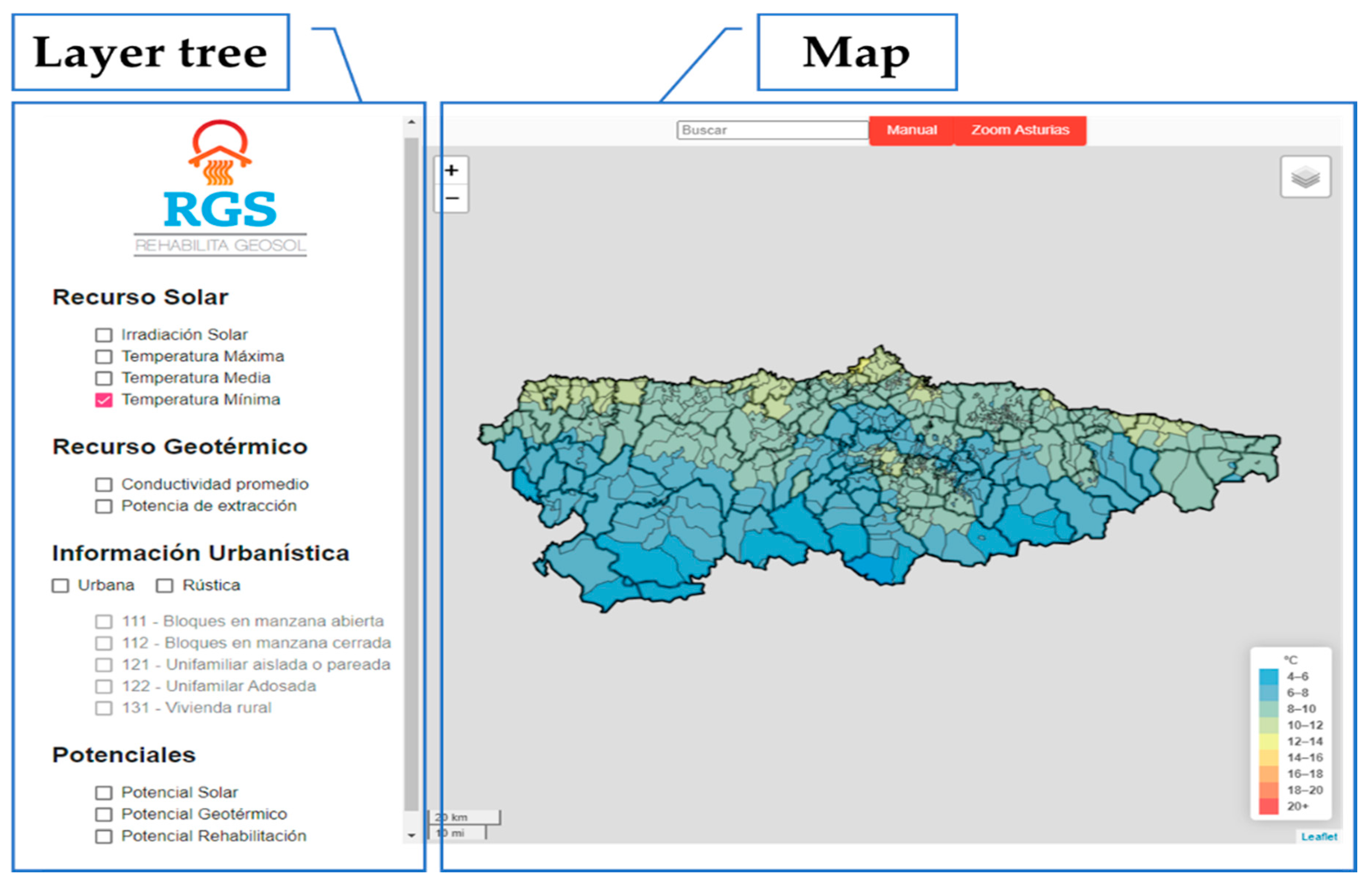







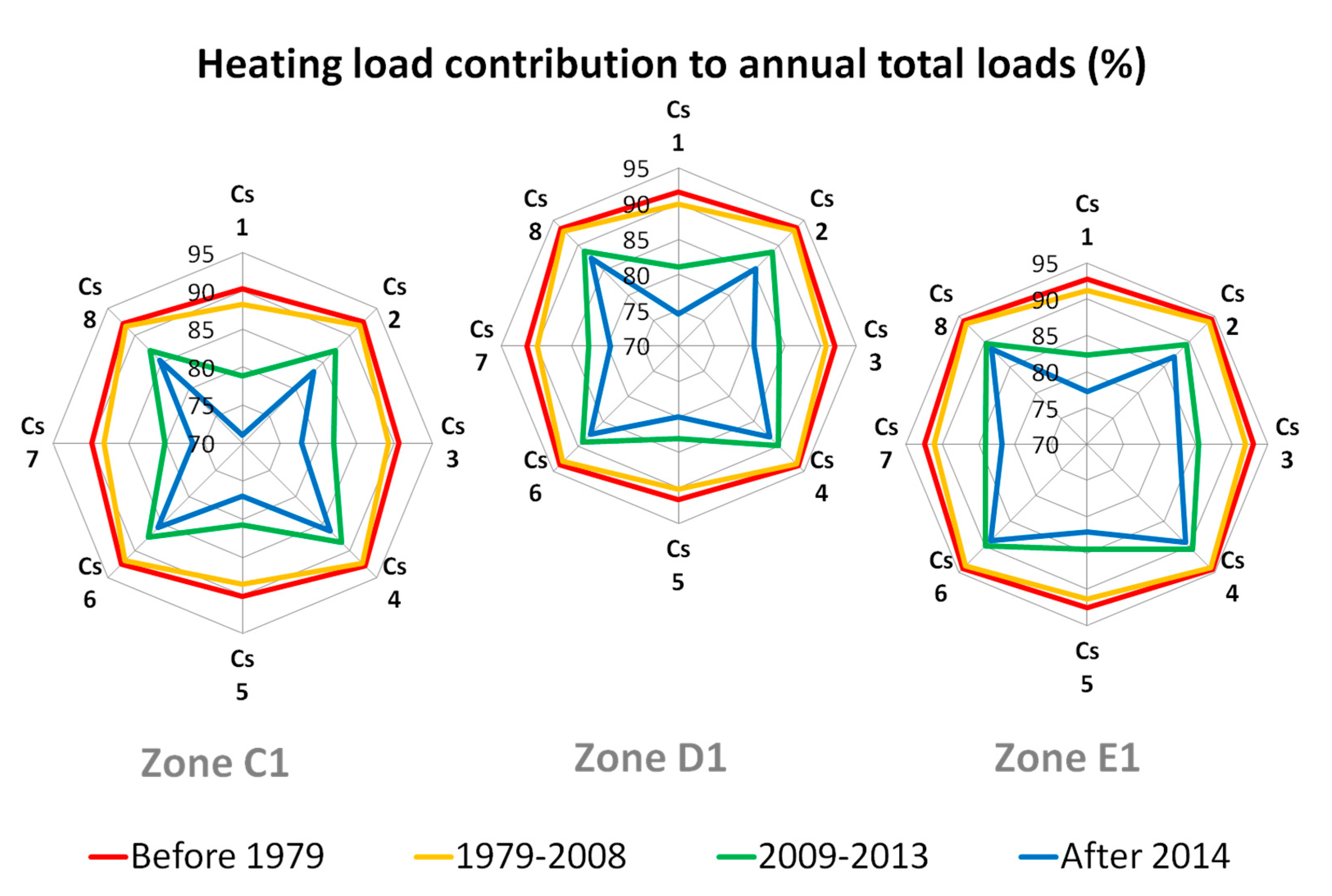
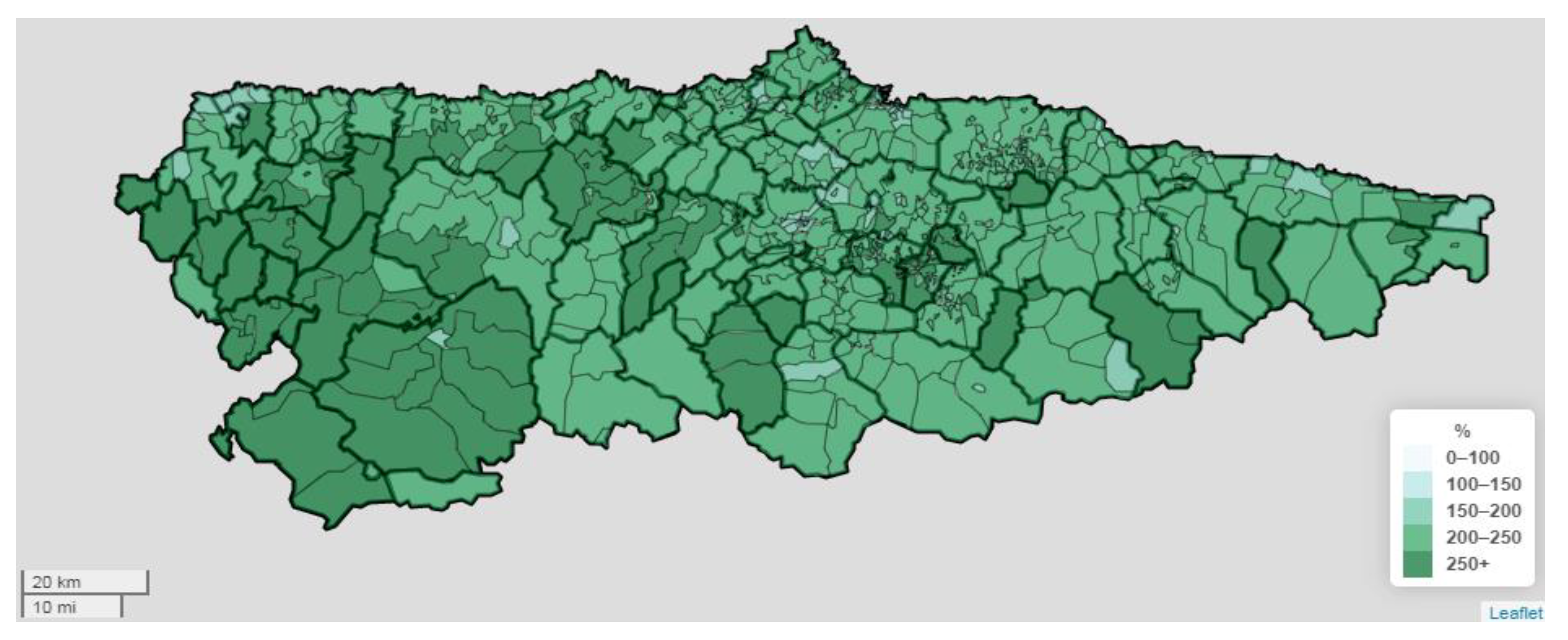

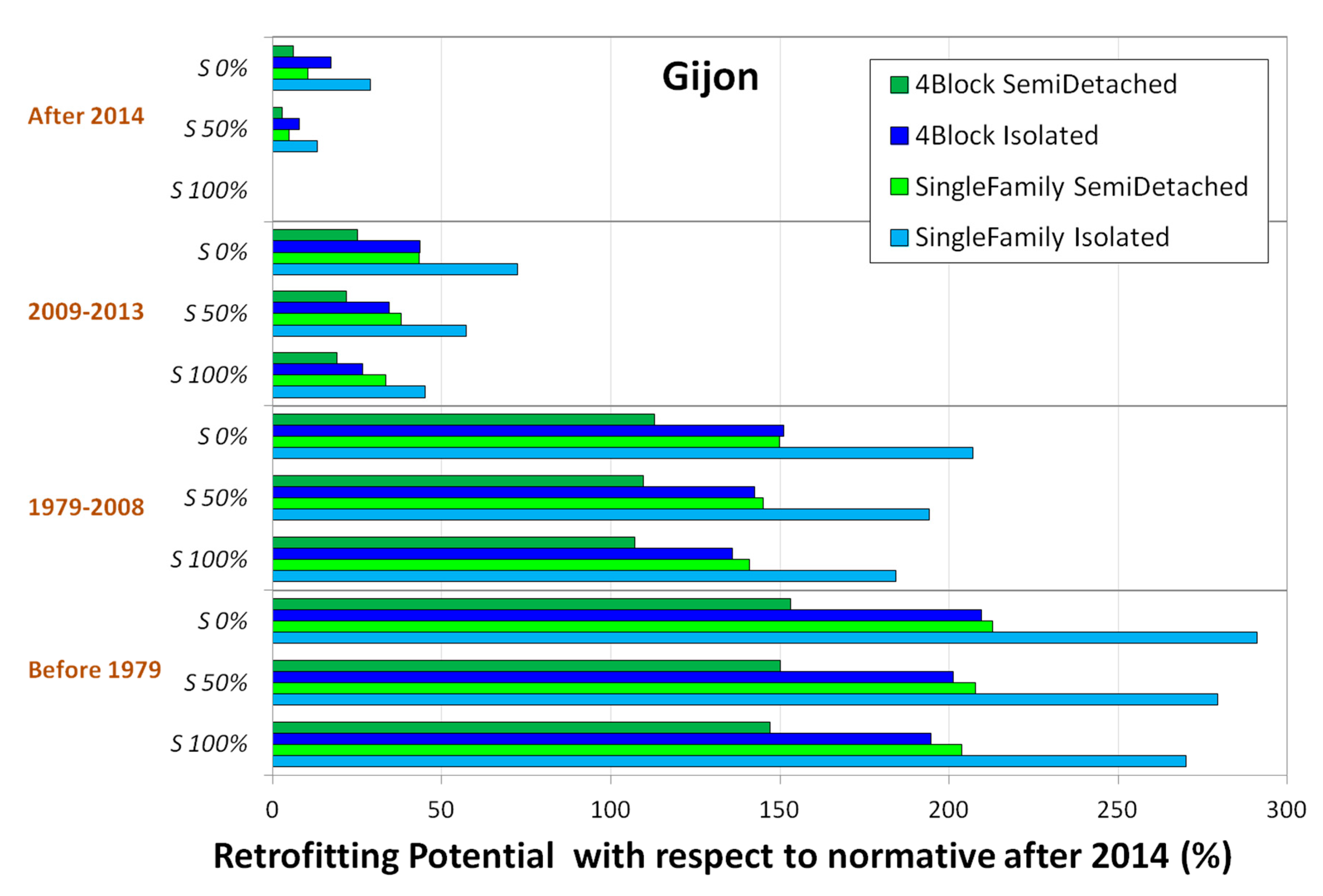
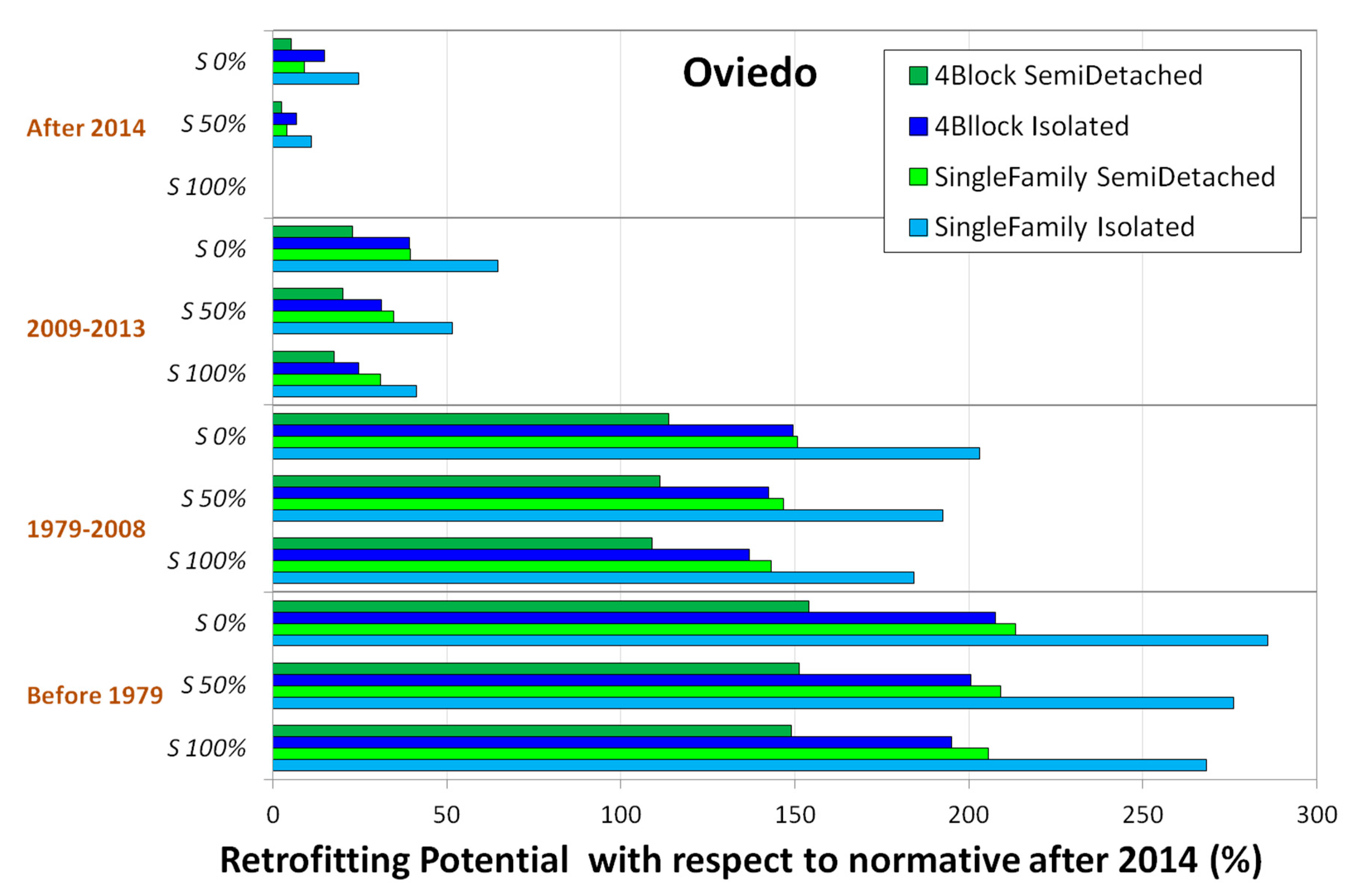
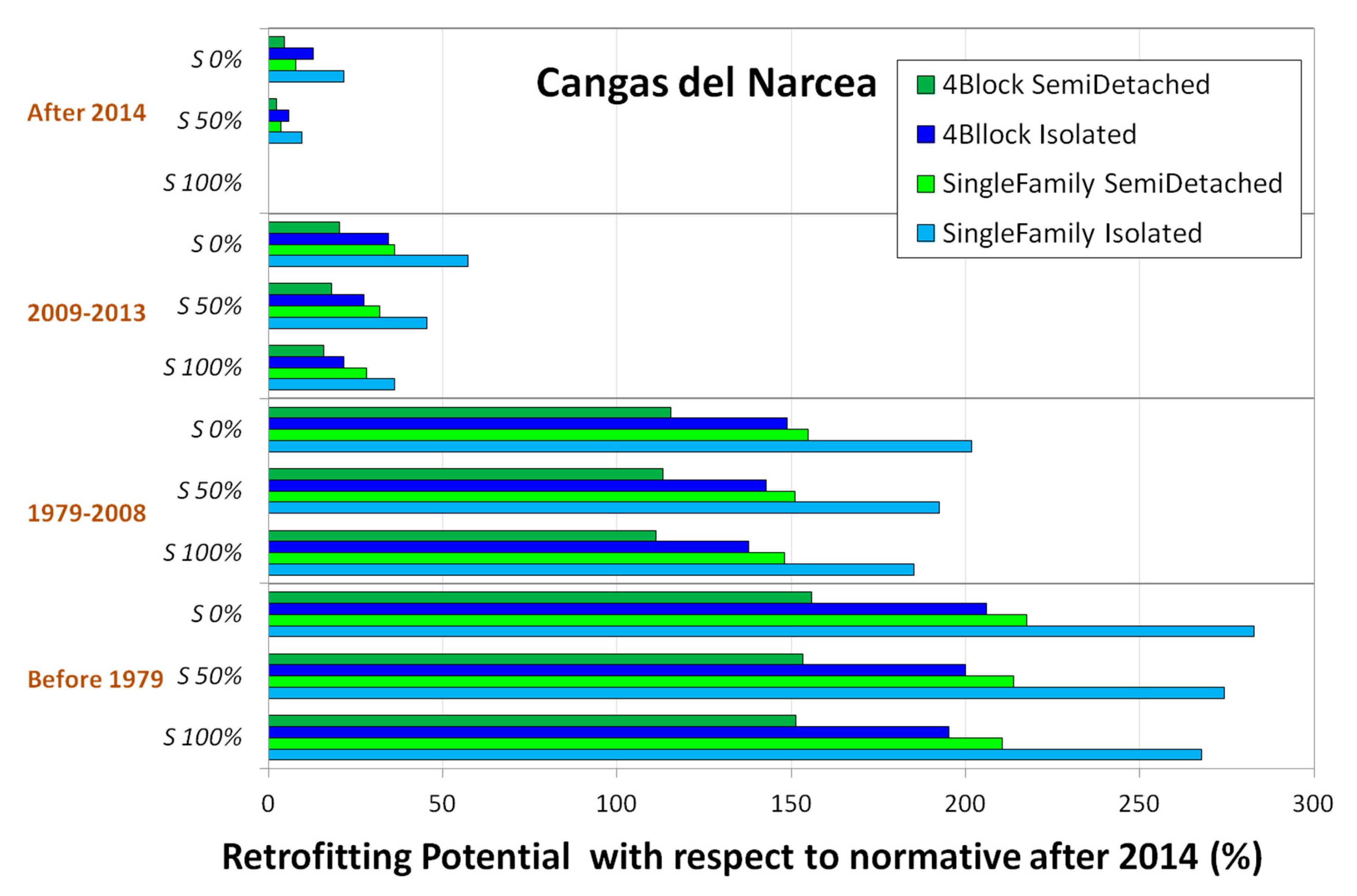
| Type of Rock | Minimum Thermal Conductivity W/(m·K) | Average Thermal Conductivity W/(m·K) | Maximum Thermal Conductivity W/(m·K) | Volumetric Specific Heat. Capacity MJ/(m3/K) |
|---|---|---|---|---|
| Basalt | 1.3 | 1.7 | 2.3 | 2.3–2.6 |
| Granite | 2.1 | 3.4 | 4.1 | 2.1–3.0 |
| Gneiss | 1.9 | 2.9 | 4.0 | 1.8–2.4 |
| Limestone | 2.5 | 2.8 | 4.0 | 2.1–2.4 |
| Year of Built | No. of Floors | Surface (m2) | Typology |
|---|---|---|---|
| Before 1979 | 1–2 | <150 | Isolated single-family home |
| 1979–2008 | 3–5 | 150–300 | Single-family homes in closed block |
| 2009–2013 | 6–8 | 300–600 | Apartment building in open block |
| After 2014 | >8 | >600 | Apartment building in closed block |
| Climate Zone | Constructive Elements | Ulimit Before 1979 | Ulimit 1979–2008 | Ulimit 2009–2013 | Ulimit After 2014 |
|---|---|---|---|---|---|
| C1 | Roof | 2.17 | 1.20 | 0.41 | 0.23 |
| External Wall | 2.38 | 1.60 | 0.73 | 0.29 | |
| Ground | 1.00 | 1.00 | 0.73 | 0.29 | |
| Internal Wall | 2.25 | 1.62 | 0.73 | 0.73 | |
| Glazing (g) | 5.73 (0.82) | 3.25 (0.76) | 1.54 (0.65) | 0.97 (0.61) | |
| D1 | Frame | 5.7 | 4.0 | 2.2 | 2.2 |
| Roof | 2.17 | 1.20 | 0.38 | 0.22 | |
| External Wall | 2.38 | 1.60 | 0.66 | 0.27 | |
| Ground | 1.00 | 1.00 | 0.66 | 0.27 | |
| Internal Wall | 2.25 | 1.62 | 0.66 | 0.27 | |
| Glazing (g) | 5.73 (0.82) | 3.25 (0.76) | 1.54 (0.65) | 0.97 (0.61) | |
| Frame | 5.7 | 4.0 | 2.2 | 2.2 | |
| E1 | Roof | 2.17 | 1.20 | 0.35 | 0.19 |
| External Wall | 2.38 | 1.60 | 0.57 | 0.25 | |
| Ground | 1.00 | 1.00 | 0.57 | 0.25 | |
| Internal Wall | 2.25 | 1.62 | 0.57 | 0.25 | |
| Glazing (g) | 5.73 (0.82) | 3.25 (0.76) | 1.54 (0.65) | 0.97 (0.61) | |
| Frame | 5.7 | 4.0 | 2.2 | 2.2 |
| Power Source | CO2 Emissions Factors (kg CO2/kWh) | Cost—Taxes Included (€/kWh) |
|---|---|---|
| Conventional electricity | 0.331 | 0.2383 |
| Gas Oil | 0.311 | 0.0727 |
| Natural gas | 0.252 | 0.0665 |
| Climatic Zone | Municipality | Postal District | Solar Savings (%) | Efficiency (%) | CO2 Savings (kg CO2/Year) |
|---|---|---|---|---|---|
| C1 | Gijón | 33208 | 36.6 | 45.2 | 234.3 |
| Avilés | 33401 | 34.6 | 45.0 | 222.2 | |
| Soto del Barco | 33125 | 51.3 | 46.9 | 328.3 | |
| Coaña | 33710 | 29.6 | 43.2 | 197.3 | |
| D1 | Oviedo | 33006 | 39.6 | 46.7 | 260.6 |
| Castrillón | 33457 | 48.7 | 47.1 | 313.7 | |
| Cudillero | 33156 | 57.4 | 47.5 | 371.3 | |
| Coaña | 33716 | 26.8 | 42.3 | 172.5 | |
| E1 | Cangas del Narcea | 33800 | 49.8 | 48.7 | 338.1 |
| Grado | 33826 | 40.1 | 48.6 | 277.0 | |
| Aller | 33676 | 38.1 | 50.3 | 275.7 |
| Type of House | Boundary Conditions | Normative | 100%t Summer Shading | 50%t Summer Shading | 0%t Summer Shading |
|---|---|---|---|---|---|
| Single-family | Isolated | Before 1979 | Case 1 | Case 2 | Case 3 |
| 1979–2008 | Case 4 | Case 5 | Case 6 | ||
| 2009–2013 | Case 7 | Case 8 | Case 9 | ||
| After 2014 | Case 10 | Case 11 | Case 12 | ||
| Semi-detached | Before 1979 | Case 13 | Case 14 | Case 15 | |
| 1979–2008 | Case 16 | Case 17 | Case 18 | ||
| 2009–2013 | Case 19 | Case 20 | Case 21 | ||
| After 2014 | Case 22 | Case 23 | Case 24 | ||
| Four-storey block (400 m2) | Isolated | Before 1979 | Case 25 | Case 26 | Case 27 |
| 1979–2008 | Case 28 | Case 29 | Case 30 | ||
| 2009–2013 | Case 31 | Case 32 | Case 33 | ||
| After 2014 | Case 34 | Case 35 | Case 36 | ||
| Semi-detached | Before 1979 | Case 37 | Case 38 | Case 39 | |
| 1979–2008 | Case 40 | Case 41 | Case 42 | ||
| 2009–2013 | Case 43 | Case 44 | Case 45 | ||
| After 2014 | Case 46 | Case 47 | Case 48 |
Publisher’s Note: MDPI stays neutral with regard to jurisdictional claims in published maps and institutional affiliations. |
© 2020 by the authors. Licensee MDPI, Basel, Switzerland. This article is an open access article distributed under the terms and conditions of the Creative Commons Attribution (CC BY) license (http://creativecommons.org/licenses/by/4.0/).
Share and Cite
Soutullo, S.; Giancola, E.; Sánchez, M.N.; Ferrer, J.A.; García, D.; Súarez, M.J.; Prieto, J.I.; Antuña-Yudego, E.; Carús, J.L.; Fernández, M.Á.; et al. Methodology for Quantifying the Energy Saving Potentials Combining Building Retrofitting, Solar Thermal Energy and Geothermal Resources. Energies 2020, 13, 5970. https://doi.org/10.3390/en13225970
Soutullo S, Giancola E, Sánchez MN, Ferrer JA, García D, Súarez MJ, Prieto JI, Antuña-Yudego E, Carús JL, Fernández MÁ, et al. Methodology for Quantifying the Energy Saving Potentials Combining Building Retrofitting, Solar Thermal Energy and Geothermal Resources. Energies. 2020; 13(22):5970. https://doi.org/10.3390/en13225970
Chicago/Turabian StyleSoutullo, Silvia, Emanuela Giancola, María Nuria Sánchez, José Antonio Ferrer, David García, María José Súarez, Jesús Ignacio Prieto, Elena Antuña-Yudego, Juan Luís Carús, Miguel Ángel Fernández, and et al. 2020. "Methodology for Quantifying the Energy Saving Potentials Combining Building Retrofitting, Solar Thermal Energy and Geothermal Resources" Energies 13, no. 22: 5970. https://doi.org/10.3390/en13225970
APA StyleSoutullo, S., Giancola, E., Sánchez, M. N., Ferrer, J. A., García, D., Súarez, M. J., Prieto, J. I., Antuña-Yudego, E., Carús, J. L., Fernández, M. Á., & Romero, M. (2020). Methodology for Quantifying the Energy Saving Potentials Combining Building Retrofitting, Solar Thermal Energy and Geothermal Resources. Energies, 13(22), 5970. https://doi.org/10.3390/en13225970








